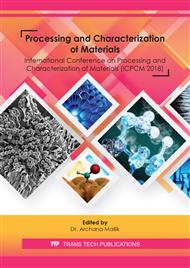p.152
p.161
p.167
p.174
p.183
p.191
p.202
p.209
p.216
Bacterial Cellulose Based Composites: Preparation and Characterization
Abstract:
Bacterial Cellulose (BC) is a biologically derived material having properties that present it as a biomaterial, with potential application in various fields. BC based composites capitalize its properties and enhance its applications. Bacterial cellulose composites were prepared with poly (methyl methacrylate) and polyvinyl alcohol and characterized for optical transmittance, structural properties and tensile test. The transmittance of composites was found to be decreased for higher BC content in composites. Scanning electron micrographs depicts the fibrous structures of bacterial cellulose embedded in PMMA matrix while diffused with PVA matrix and dimension of fibres are in nanometer. Tensile strength of the composites were varying with the change in BC content with maximum strength in BC-PMMA and BC-PVA composites is of 2%BC in PMMA and 25% BC in PVA, respectively. This work is intended to impel research activity for applications of BC composites in area of packaging materials, tissue engineering, and wound dressing materials.
Info:
Periodical:
Pages:
183-190
Citation:
Online since:
February 2020
Authors:
Keywords:
Price:
Сopyright:
© 2020 Trans Tech Publications Ltd. All Rights Reserved
Share:
Citation:


